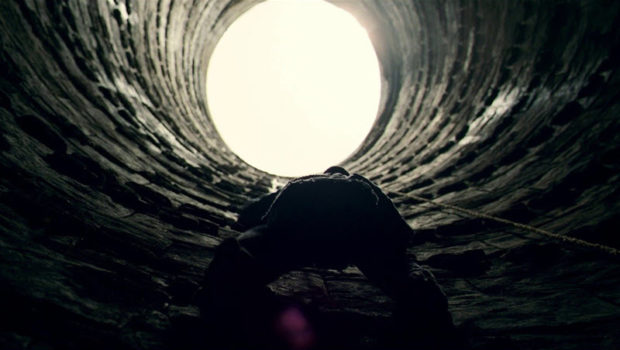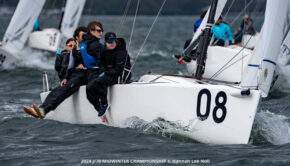The Good, The Bad, and The Ugly
Published on March 5th, 2017
Gail Turluck, Board member for the Lake Michigan Sail Racing Federation, has spent at least 50 years enjoying and contributing to the sport of sailing. For the past 5 ½ years, this Chicagoan has specifically been working daily to cause growth in the sport. Here she shares her observations in this report.
Offshore Handicap Fleets
Offshore handicap racing is at a break point. There are so many rules and none have been declared obsolete. As a result, owners are sitting out rather than acquiring multiple handicaps due to cost. More people are opting for offshore one-designs, with local yacht clubs competing to hold races for these Classes. This has drawn down participation in traditional regional events and causing dissatisfaction at all events due to “small fleet size.”
We’re doing a poor job of reaching the people who buy the used offshore boats to draw them to keep PHRF boats out racing (I try … but I’m only one person). Older boats’ owners don’t feel the newer rating rules give them a fair shot at competing evenly or have had experiences that have driven them away. There need to be lots of seminars to educate these owners on up and coming rules and the potential benefits of embracing them.
Cost drives those owners; they have a boat that is paid for and sails that are good enough (they might buy one new sail every 4-8 years). If they suffer a major equipment loss (broken mast, hole from a collision, etc.), they lose a season or are gone forever. While they can come up with funds for storage, mooring, race entry, and general maintenance, growing handicap costs generate a “no” answer.
Inshore One Design Fleets
Junior sailing is incredibly active though completely different than when I was a junior. Except for the Sears Cup and RSA events (later the Bemis and Smythe were added, and much later the US Youth Championship), there were no “travel” events during my era. Junior fleets at each club were big, thriving, racing spring, summer and fall. Many kids owned their own boats—often Sunfish, and sometimes traveled to a regatta 20 or 40 miles away. Mom and Dad weren’t the boat owners.
In today’s climate, we just don’t have kids owning boats. The hunt for perfect equipment is contributory to kids not being owners; they can’t afford it. When youth sailing focused on Lasers and Club FJs and Club 420s, Inshore One-Design development and support simply fell off a cliff. The US strength in sailing was how we had people sailing all kinds of equipment at all kinds of places; every harbor had 3 to 6 Classes racing regularly. Every beach had a Sunfish fleet with 15-75 boats out racing regularly, boats were sold to a next owner who was implored to come and race, and new boats were acquired and added to the trickle down.
We must focus on re-growing our Inshore One-Design fleets, getting people started in a 14 footer, so they discover they want a 17 footer, and then a 22 footer … the old, traditional 3-foot-itis. Obviously, not everyone can afford to get up to a TP 52 or a Farr 40, but to rebuild our strength, we need all those people out sailing, building their boat handling, sailing, and racing rules skills, and working to replace themselves, too. I remember 80 boat 470 fleets for a regional event. Things have now gotten too perfect.
Socializing
I remember during big boat race events that many people socialized on their boats, in the harbor, having brought along their hors d’oeuvres for serving after the race. Today, the competitive nature has led to owners not carrying “this excess weight.”
Socializing has been driven ashore—to the parking lot and not inside, dressed nicely, and seated at a table; or worse yet, back home for locals or to the hotel for visitors trying to control the cost of travel, hotel, restaurants, and all the rest that has become “the model” for big event sailing today.
The Sunfish remains an exception in my experience—when permitted, you will find a big area of campers in tents, popups, minivans and a very few motorhomes. We need more sailing venues where “camping” is welcomed!
Exposure
America’s Cup is good only to get sailing as a concept out in the media and perhaps drawing some interest by the general public to the concept of sailing. On Lake Michigan, we worked to guide people to discover our clubs and programs before, during, and after the 2016 America’s Cup World Series event in Chicago. We found a noticeable uptick in interest and we have growth.
High School
High School sailing is parent driven; when parents are there who care, there is a team and participation at a center that has a coach is enabled. Centers are offering programs to “sailing teams.” As long as these programs stay in provided equipment (primarily 420/FJ/Laser/Laser Radial), as most of the equipment is owned by another entity (yacht clubs or sailing centers) and a fee covers the boat use, they will continue to thrive. There would have to be a nation-wide decision to change equipment, a means to fund such a change, and a reliable supply a large quantity of boats in a short time, maybe a few years. Cost is what has kept programs in what we have.
College
College sailing is experiencing some issues. The Inter-Collegiate Sailing Association has a contract with a sponsor that mandates the College Nationals hosts for singlehanded and doublehanded championships to use boats made by LaserPerformance. The cost of the LaserPerformance boats is higher than alternatives, and some say the quality from other builders is higher.
College sailing has set an expectation for the spring doublehanded championships be held in new boats annually. In many conferences, regattas are routinely held in boats that are significantly older, and while not perfectly even equipment, the round robin format equalizes the effect fairly well. Boats that are 5 years old or younger are perfectly adequate for a national championship, yet excluded.
The cost of fleet acquisition led to the Midwest Conference having to step back in 2017 from its regular turn as host for the spring events-Coed Dinghy, Team Race and Women’s Dinghy-as the consortium working to host (Wisconsin, Chicago Yacht Club, others), had found enough interested buyers, was working to raise funds to acquire the fleet required, but could not arrange financing of the purchase in time to satisfy the demands of the ICSA.
If we back up to 1975, there were no coaches in college sailing. Each college sailing club was fully student-directed. Events were well attended, no matter what in the heck was being sailed. In some of the conferences a number of schools have coaches; a couple have a couple or few schools with coaches. The exception is those schools with full-time coaching yet it is these schools that are calling all the shots for what college sailing now is.
I can speak to college sailing in the Midwest—regatta attendance and participation is down while the number of teams grows. It doesn’t make sense. The disconnect from club teams to varsity teams is deep and growing. College “kids” used to own boats while they were college sailors—470s, Thistles, Flying Scots, Lightnings, Rebels, Sunfish. Today, this is a rare thing.
Evolution
We are finally seeing the break point of more and more one-designs being created causing ultimate dilution. With over 500,000 Sunfish having been built, it is difficult to get 50 of them together for a single event routinely. Other factors also contributing are windward-leeward courses for a boat that planes on a reach, somewhat technical rigging perceived to be expensive parts, and difficult to get parts.
The J/70 has been hailed as sailing’s savior. Lots of people with different, often bigger, boats bought a J/70. It brought a new group of people together who discovered the same old issues: professionals, upgrade requirements, cost of participation, not being what they expected, etc. What happened to all their old boats? They are sitting on the hard someplace while these owners decide if they are staying with the J/70 or going back to their old boat. No growth, just rearrangement.
At $70K to get started, high school, college and recent grads aren’t going to be showing up anytime soon. If I wanted a new boat, I would probably buy a Flying Scot. It is a strong national Class with a local fleet in my area. It has strong traditions, fair sailors, family values, and has good events to travel to.
Marketing
Sail racing needs to market itself. The manufacturers are not showing interest in this concept; they just want to sell boats—racing is 10% of the market. I keep trying to cause my one-design Class of choice to do some mass marketing. In today’s multiple interest lifestyle, a web page simply is not enough.
A strong cross-platform of marketing—local sailboat shows for big and little sailboats; go for a sailboat ride days (we should all simply be rallying on the Summer Sailstice and agree as a sport that we will not race that one weekend a year and take the public out for a sail); local demo days from boat vendors all across the US routinely; advertising in general media and sailing media, strategically causing articles to appear from time to time in publications like Parade, Popular Science, Good Housekeeping, Outdoor Life, Outside, Salt Water Sportsman, New York Times, Chicago Tribune, Los Angeles Times, etc.; social media marketing; websites; strategic news releases and much, much more. There will be a cost. I dig in my own pocket from time to time, but it’s not very deep. Then there are the legalities of what organizations can do.
Effort
It is possible to save the sport but it is going to take a lot of work. After 5 years, we are finally starting to see some signs of growth on Lake Michigan. I never dreamed it would have taken so long. We as a sport also need to get back to our historical collaborative approach to growing the sport.
To grow it, we need to check egos at the door. This is difficult for many to do. As time has passed, being chair of an event or Commodore someplace has become a big “feather in the cap,” not necessarily an opportunity to come in with a plan, build a team to implement ideas, and make things happen. I pray we can get back to those days. There is too much disintegration occurring at this time.
I am living, eating and breathing this issue every day. I have been going to boat shows trying to find a way to cause my suggested solutions to occur. Boat builders and sellers want an immediate return for an event and that is likely unrealistic. There is a lot of work to be done but I remain hopeful enough people care that we can make it happen.









 We’ll keep your information safe.
We’ll keep your information safe.